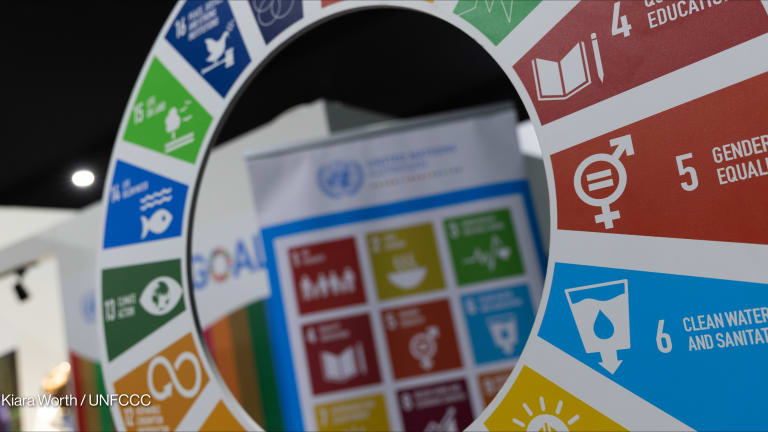
The COVID-19 pandemic made technology essential for many people to work, communicate with friends and family, and access services related to their health, finances, education, and more.
While this has driven interest in the potential of disruptive technologies in emerging markets, it has also exposed their limitations, due to factors ranging from gaps in internet access to pilots failing to go to scale.
With 2021 coming to a close, Devex spoke with experts about which technologies with potential for impact in global health and international development either failed to meet or exceeded expectations.
“Technology is at best half of the puzzle,” said Alexa Roscoe, disruptive technologies lead at the International Finance Corporation.
For example, if online education enables more women to learn from home but thereby reduces efforts for equal and safe access to lessons in the classroom, that cannot be counted as a unilateral win, she said.
“Technology gets overhyped when not enough is done to ensure it reaches the people that need it most,” Roscoe said in an email. “Disruptive technology cannot fulfill its promise and potential if it’s not designed for users in emerging markets.”
While tech for development had some big wins, it failed to live up to the hype across a number of sectors, particularly in low-resource settings that have the potential to see the most benefit.
Digital health
As COVID-19 accelerates digital health innovation, 'Who will we leave behind?'
The pandemic has fast-tracked innovation in the virtual health care system. Models that ensure global access must follow, said experts attending the annual trade show CES.
The pandemic has fast-tracked innovation in the virtual health care system. Emerging technologies are analyzing large amounts of data, tracking the transmission of COVID-19 and other diseases, and diagnosing and treating patients remotely. But the more benefits these innovations bring, the more urgency there is to identify models that ensure global access to digital health tools, experts tell Devex.
Telehealth and telemedicine are examples of technologies that exceeded expectations, said Natasha Sunderji, global health lead at consulting company Accenture.
The COVID-19 pandemic has also accelerated innovation in data visualization and genomic sequencing technologies, she added in an email to Devex.
But while significant hype surrounds artificial intelligence and machine learning, these technologies have not delivered to the full extent possible, Sunderji said. She mentioned chatbots — software programs that use automation to interact with people through voice or text — as an example of a space that has suffered from “pilotitis,” failing to scale projects past the pilot stage.
Financial inclusion
While contact tracing apps for COVID-19 have not had the kind of global impact that most had hoped for, some of the same unique identification technology has been a game changer for digital financial services, said Anit Mukherjee, a policy fellow at the Center for Global Development.
“Overhyped: COVID contact tracing apps,” he tweeted when asked about the most overrated and underrated global development technologies, adding, “star performer: mobile wallets/money.”
A combination of factors — including technology and usage challenges, the lack of smartphone coverage globally, and privacy concerns — have prevented contact tracing apps from living up to their promised potential.
Meanwhile, 1.5 billion people worldwide have participated in government-led cash transfer programs to respond to the economic impacts of the COVID-19 pandemic.
According to Mukherjee, these digital government-to-person payments were able to build on the ecosystem that was developed to support so-called mobile money in low- and middle-income countries, or LMICs.
Still, a March 2020 report from CGD found that “just 56% of citizens across 99 developing countries have access to a phone, a bank account, and an ID” — the building blocks for the successful rollout of digital cash transfers.
Educational technology
While remote learning was an option for many children around the world as the COVID-19 pandemic forced 1.6 billion kids out of school, it was out of reach for a large number, including the young people whom Street Child works with in countries like Nepal, South Sudan, and Cameroon.
Ed tech, long overhyped, missed its moment amid COVID-19. What now?
Devex speaks with the experts about how low-cost education technology might ensure more equitable access to remote learning during the pandemic and in any future disruptions to schooling.
“We think online learning has been overhyped generally,” said Anna Bowden, the CEO at Street Child US, which supports the U.K. charity’s efforts to create educational opportunities for the most vulnerable and marginalized children in Africa and Asia. “Governments are shifting to digital solutions to minimize remote learning losses, but kids most at risk of learning losses can’t access them.”
Street Child developed a “last mile” learning program using offline solutions including radios, solar-powered MP3 players, and packs of educational materials to reach students.
“You have to go out of your way to find out what people can access before you get to a tech solution,” Bowden added. “You need power, you need connectivity, you need hardware, you need somebody who understands the hardware not just well enough to use it but to fix it when it breaks, you need basic literacy and numeracy.”
Experts told Devex that the latest and greatest emerging technology may not be the way to reverse the learning losses resulting from the pandemic. Instead, low-cost and relatively simple tech solutions can ensure more equitable access to interactive online learning, both during the current health crisis and in any future disruptions to schooling. Examples include text messaging, phone calls, and radio.
Reaching people from a distance
More reading:
► To meet needs from a distance, NGOs turn to chatbots
► 'It's not about spamming communities': How to leverage messaging apps
COVID-19 gave rise to a number of new ways for NGOs to communicate with people from a distance. As Devex reported, organizations that invested in chatbots before the pandemic are now finding messaging at the center of what they do, while those without programs in place are working to catch up. After nearly two years of leveraging tools like text messaging, voice calls, and online messaging, NGOs are learning what does and doesn’t work to reach the people they serve.
Angela Oduor Lungati, the executive director at Ushahidi — a nonprofit technology company that develops open-source software to collect, visualize, and map data — said that text messaging is often overlooked, even though it is “the lowest hanging fruit” for engaging with people in LMICs.
“As much as internet connectivity is becoming more and more accessible, affordability is still an issue, especially with the economic downturn the COVID-19 pandemic has brought about,” she said in an email to Devex.
And while WhatsApp, which Facebook — now Meta — acquired in 2014, has wide reach in LMICs, Lungati noted a few challenges that stand in the way of the platform reaching its full potential for international development organizations.
“It’s still very much a closed platform. Integration to enable sharing of data with other platforms is tedious at best and has to be done through intermediaries. In addition, the price entry point is high thus locking out many organizations in LMICs,” she said.
Turn.io, which grew out of the work that the nonprofit Praekelt.org has done with the MomConnect initiative in South Africa, is now working with social impact organizations to use WhatsApp for automated conversations at scale.
Living up to the hype? Implementation is key
Mulago Foundation’s CEO, Kevin Starr, listed automated chat and the work of Turn.io — which it has supported — among the underrated technologies of 2021.
Starr said other underrated technologies include software to manage logistics and supply chains for vaccines and other essential medicines; initiatives to electrify high-polluting urban vehicles for low-income populations, such as Three Wheels United, which is starting with rickshaws in India; and telemedicine, including mental health teletherapy.
Like so many technologies, whether telemedicine is overrated or underrated can depend on the implementation, he said.
As technologies make the transition from initial invention to widespread application, they tend to go through a cycle of hype. As ICTworks puts it, hype typically inflates expectations beyond the actual impacts of the technology, and when those do not pan out, people start to be disillusioned by unfulfilled promises. At that point, it becomes time to figure out ways to use the technology productively.
What is useful now — or could be in the future
One example that often comes up in conversations about the hype cycle is blockchain, a decentralized system of record-keeping for series of transactions.
Tech Matters partnership leverages tech for global child helplines
Tech Matters, a Silicon Valley-based nonprofit organization, launched the Aselo platform to help child helplines work more effectively. Zambia and South Africa child helplines are the first to switch.
For years, blockchain’s potential for impact in international development has been much discussed but poorly understood.
Blockchain and the metaverse — an immersive digital world of virtual gatherings and various other experiences — are 2021’s most overrated technologies, said Jim Fruchterman, the founder and CEO of Tech Matters, a Silicon Valley-based nonprofit organization that supports social sector leaders to make smarter technology investments.
But this is not “because they won’t be important someday,” he said, adding that “they probably will.”
Instead, they “just are so far from being useful to social good leaders as to be a waste of time.”
Fruchterman called so-called software as a service — or SaaS, which allows users to connect to cloud-based apps over the internet — an underrated technology.
“If I were a dentist, there are probably five or ten platforms built to help my practice schedule, bill and generally allow me to be a great dentist,” he wrote to Devex.
Because the social sector doesn’t have access to better SaaS options, great projects tend to be hobbled together using spreadsheets or other makeshift technologies, Fruchterman said, and this is one problem that Tech Matters is trying to address.
Fruchterman also highlighted the Internet of Things, or IoT, as an underrated technology, acknowledging that this remote sensing technology has been part of the hype cycle before.
“I know, underhyped fads are yesteryear’s overhyped ones,” he said. “But I see this tech as having pretty exciting potential for impact in the upcoming years.”
Fruchterman mentioned Nexleaf Analytics, which has created wireless sensor devices and data analytics tools for cookstove usage and vaccine delivery, as an example of an organization showing the potential of IoT in LMICs.
What would you add to the list? Share with us which technologies exceeded your expectations, failed to deliver, or present exciting potential moving forward via Twitter or email me at catherine.cheney@devex.com.








